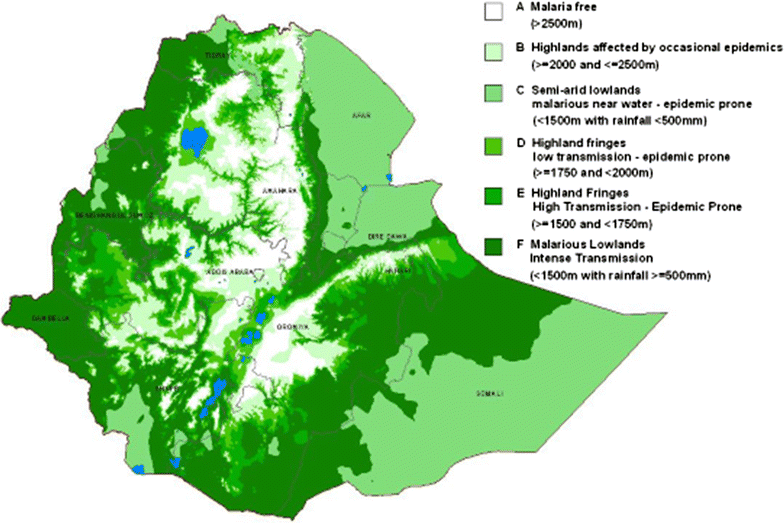Use of epidemiological and entomological tools in the control and elimination of malaria in Ethiopia
- PMID: 29329545
- PMCID: PMC5767068
- DOI: 10.1186/s12936-018-2172-1
Use of epidemiological and entomological tools in the control and elimination of malaria in Ethiopia
Abstract
Malaria is the leading public health problem in Ethiopia where over 75% of the land surface is at risk with varying intensities depending on altitude and season. Although the mortality because of malaria infection has declined much during the last 15-20 years, some researchers worry that this success story may not be sustainable. Past notable achievements in the reduction of malaria disease burden could be reversed in the future. To interrupt, or even to eliminate malaria transmission in Ethiopia, there is a need to implement a wide range of interventions that include insecticide-treated bed nets, indoor residual spraying, improved control of residual malaria transmission, and improved diagnostics, enhanced surveillance, and methods to deal with the emergence of resistance both to drugs and to insecticides. Developments during the past years with increasing awareness about the role of very low levels of malaria prevalence can sustain infections, may also demand that tools not used in the routine control efforts to reduce or eliminate malaria, should now be made available in places where malaria transmission occurs.
Keywords: Elimination; Entomology; Epidemiology; Malaria; Survey.
Figures
Similar articles
-
Mapping residual transmission for malaria elimination.Elife. 2015 Dec 29;4:e09520. doi: 10.7554/eLife.09520. Elife. 2015. PMID: 26714110 Free PMC article.
-
Targeting populations at higher risk for malaria: a survey of national malaria elimination programmes in the Asia Pacific.Malar J. 2016 May 10;15(1):271. doi: 10.1186/s12936-016-1319-1. Malar J. 2016. PMID: 27165296 Free PMC article.
-
Challenges for malaria elimination in Brazil.Malar J. 2016 May 20;15(1):284. doi: 10.1186/s12936-016-1335-1. Malar J. 2016. PMID: 27206924 Free PMC article. Review.
-
Setting the scene and generating evidence for malaria elimination in Southern Mozambique.Malar J. 2019 Jun 6;18(1):190. doi: 10.1186/s12936-019-2832-9. Malar J. 2019. PMID: 31170984 Free PMC article. Review.
-
An observational analysis of the impact of indoor residual spraying with non-pyrethroid insecticides on the incidence of malaria in Ségou Region, Mali: 2012-2015.Malar J. 2018 Jan 10;17(1):19. doi: 10.1186/s12936-017-2168-2. Malar J. 2018. PMID: 29316917 Free PMC article.
Cited by
-
Reshaping the vector control strategy for malaria elimination in Ethiopia in the context of current evidence and new tools: opportunities and challenges.Malar J. 2018 Dec 5;17(1):454. doi: 10.1186/s12936-018-2607-8. Malar J. 2018. PMID: 30518395 Free PMC article. Review.
-
Asymptomatic malaria and nurturing factors in lowlands of Ethiopia: A community based cross-sectional study.PLOS Glob Public Health. 2022 Aug 16;2(8):e0000659. doi: 10.1371/journal.pgph.0000659. eCollection 2022. PLOS Glob Public Health. 2022. PMID: 36962734 Free PMC article.
-
Antimalarial Effect of the Root of Silene macrosolen A. Rich (Caryophyllaceae) on Plasmodium-berghei-Infected Mice.Evid Based Complement Alternat Med. 2021 Mar 16;2021:8833865. doi: 10.1155/2021/8833865. eCollection 2021. Evid Based Complement Alternat Med. 2021. PMID: 37601484 Free PMC article.
-
Plant-based nanoparticles targeting malaria management.Front Pharmacol. 2024 Aug 9;15:1440116. doi: 10.3389/fphar.2024.1440116. eCollection 2024. Front Pharmacol. 2024. PMID: 39185312 Free PMC article. Review.
-
Malaria therapeutics: are we close enough?Parasit Vectors. 2023 Apr 14;16(1):130. doi: 10.1186/s13071-023-05755-8. Parasit Vectors. 2023. PMID: 37060004 Free PMC article. Review.
References
-
- Manson-Bahr P. The prevalent disease of Italian East Africa. Lancet. 1941;237:609–612. doi: 10.1016/S0140-6736(00)95196-1. - DOI
-
- Abeku TA, de Vlas SJ, Borsboom G, Teklehaimanot A, Kebede A, Olana D, et al. Forecasting malaria incidence from historical morbidity patterns in epidemic-prone areas of Ethiopia: a simple seasonal adjustment method performs best. Trop Med Int Health. 2002;7:851–857. doi: 10.1046/j.1365-3156.2002.00924.x. - DOI - PubMed
Publication types
MeSH terms
LinkOut - more resources
Full Text Sources
Other Literature Sources
Medical
Miscellaneous


